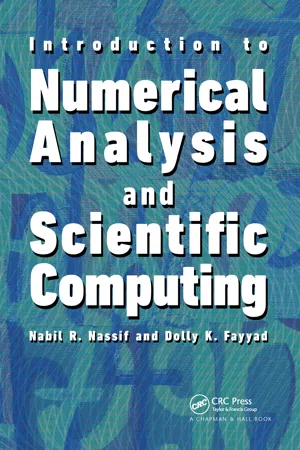
eBook - ePub
Introduction to Numerical Analysis and Scientific Computing
Nabil Nassif, Dolly Khuwayri Fayyad
This is a test
Partager le livre
- 329 pages
- English
- ePUB (adapté aux mobiles)
- Disponible sur iOS et Android
eBook - ePub
Introduction to Numerical Analysis and Scientific Computing
Nabil Nassif, Dolly Khuwayri Fayyad
Détails du livre
Aperçu du livre
Table des matières
Citations
À propos de ce livre
Designed for a one-semester course, Introduction to Numerical Analysis and Scientific Computing presents fundamental concepts of numerical mathematics and explains how to implement and program numerical methods. The classroom-tested text helps students understand floating point number representations, particularly those pertaining to IEEE simple an
Foire aux questions
Comment puis-je résilier mon abonnement ?
Il vous suffit de vous rendre dans la section compte dans paramètres et de cliquer sur « Résilier l’abonnement ». C’est aussi simple que cela ! Une fois que vous aurez résilié votre abonnement, il restera actif pour le reste de la période pour laquelle vous avez payé. Découvrez-en plus ici.
Puis-je / comment puis-je télécharger des livres ?
Pour le moment, tous nos livres en format ePub adaptés aux mobiles peuvent être téléchargés via l’application. La plupart de nos PDF sont également disponibles en téléchargement et les autres seront téléchargeables très prochainement. Découvrez-en plus ici.
Quelle est la différence entre les formules tarifaires ?
Les deux abonnements vous donnent un accès complet à la bibliothèque et à toutes les fonctionnalités de Perlego. Les seules différences sont les tarifs ainsi que la période d’abonnement : avec l’abonnement annuel, vous économiserez environ 30 % par rapport à 12 mois d’abonnement mensuel.
Qu’est-ce que Perlego ?
Nous sommes un service d’abonnement à des ouvrages universitaires en ligne, où vous pouvez accéder à toute une bibliothèque pour un prix inférieur à celui d’un seul livre par mois. Avec plus d’un million de livres sur plus de 1 000 sujets, nous avons ce qu’il vous faut ! Découvrez-en plus ici.
Prenez-vous en charge la synthèse vocale ?
Recherchez le symbole Écouter sur votre prochain livre pour voir si vous pouvez l’écouter. L’outil Écouter lit le texte à haute voix pour vous, en surlignant le passage qui est en cours de lecture. Vous pouvez le mettre sur pause, l’accélérer ou le ralentir. Découvrez-en plus ici.
Est-ce que Introduction to Numerical Analysis and Scientific Computing est un PDF/ePUB en ligne ?
Oui, vous pouvez accéder à Introduction to Numerical Analysis and Scientific Computing par Nabil Nassif, Dolly Khuwayri Fayyad en format PDF et/ou ePUB ainsi qu’à d’autres livres populaires dans Matemáticas et Matemáticas general. Nous disposons de plus d’un million d’ouvrages à découvrir dans notre catalogue.
Informations
Chapter 1
Computer Number Systems and Floating Point Arithmetic
1.1Introduction
1.2Conversion from Base 10 to Base 2
1.2.1Conversion of the Integral Part
1.2.2Conversion of the Fractional Part
1.3Conversion from Base 2 to Base 10
1.3.1Polynomial Evaluation
1.3.2Conversion of the Integral Part
1.3.3Conversion of the HYactional Part
1.4Normalized Floating Point Systems
1.4.1Introductory Concepts
1.4.2IEEE Floating Point Systems
1.4.3Denormalized Numbers in MATLAB
1.4.4Rounding Errors in Floating Point Representation
1.5Floating Point Operations
1.5.1Algebraic Properties in Floating Point Operations
1.5.2The Problem of Absorption
1.5.3The Problem of Cancellation or Loss of Precision
1.6Computing in a Floating Point System
1.6.1Cardinality and Distribution of Floating Point Systems
1.6.2A MATLAB Simulation of a Floating Point System
1.6.3Tips for Floating Point Computation
1.7Exercises
1.8Computer Projects
1.1 Introduction
The main objective of this chapter is to introduce the students to modes of storage of users’ numbers in a computer memory and as well providing the readers with basic concepts of computer arithmetic, referred to also as Floating Point Arithmetic. Although the principles covered are general and can apply to any finite precision arithmetic system, we apply those principles only to Single and Double Precision IEEE (Institute of Electrical and Electronics Engineers) systems. For additional detailed references, we refer to [8], [14], [19] and [23].
In this view, we start by describing computer number representation in the binary system that uses 2 as the base. Since the usual decimal system uses base 10, we discuss therefore methods of conversion from one base to another. The octal and hexadecimal systems (respectively, base 8 and base 16 systems) are also introduced as they are often needed as intermediate stages b...